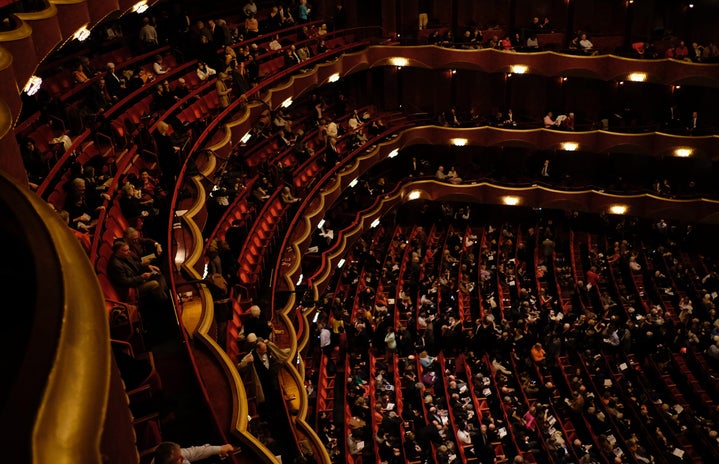Kenyon College is home to a plethora of delightful things: superb academics, a stunning campus, a rich history, and some pretty cool dogs. It is also home to an involved student body that, despite being a mere 1600 students, sends a whole lot of emails. Now, there are a few ways Kenyon students tackle their overflowing inboxes: they unsubscribe from “allstu” emails, they simply don’t check their email, or, like me, check each email as it arrives so as to not miss a thing.
Without checking my email as ridiculously often as I do, I simply wouldn’t have thought to attend many of the random, yet engaging, events I’ve been to in this last year. Usually, I’ll see an email announcing an author coming to read in the Cheever Room in Finn House or a performer or activist speaking in Brandi, and I’ll panic a little. What about all of my work? What about that nap I so desperately wanted? While self-care is obviously important, I find that, for myself, a lot of these questions are often cop-outs to not broaden my horizons in the interest of more comfortable activities. So, I do my best to push past these questions, and I write down when and where the visitor will be on my whiteboard calendar a few days beforehand. More often than not, I simply go, and, usually, I go by myself.
This year I’ve been in packed rooms and empty ones, with dramatically different speakers sharing their dramatically different voices. However, three of these readings were particularly impactful for me. Upon reflecting on why these three specific voices moved me amidst some truly incredible talks, I realize that these three artists, two poets, and one performer, are all queer. Not only is this an identity that I share with them, but their queerness, while not defining them as artists, shapes how they see the world, and this bleeds through in their craft in beautiful, meaningful ways.
Rajiv Mohabir
On September 18, 2017, I entered the Cheever Seminar Room for my second time, the first being a sample creative writing class I attended at Admitted Students’ Weekend—the class that pushed me to choose to attend Kenyon. I was there at the recommendation of my English professor, Janet McAdams, who taught my “Queer Texts, Queer Tales” class.
Unlike the other two artists mentioned in this article, at the time that I saw Rajiv Mohabir speak, I was already intimately familiar with his book The Taxidermist’s Cut, as we were reading it in class. However, hearing something you’ve only ever read silently in your internal monologue voice being read aloud by the very person who penned those words is a pretty surreal experience. I’d gone to a handful of poetry readings in high school, but rarely did I get to be a mere few yards away from the poet, only to have him visit my class the following day and sign my copy of his incredible work.
Mohabir’s The Taxidermist’s Cut uses the conceit of taxidermy to grapple with issues of homophobia, both internal and external, colorism and racism, immigration, and self-harm. Growing up in a small town in Florida, poetry was an outlet for Mohabir to process the discrimination he faced for many of his identities. And yet, despite the trials he endured both in his small hometown and in his young adult life in various cities across the U.S., he stood before us that September evening, laughing and warm, sharing his stories with us. I was positively floored.
Paul Tran
The strange, magical feeling that I felt hearing Rajiv Mohabir came to me again when Paul Tran visited this January to read their work in that same, magical room. I wasn’t prompted to attend by a professor this time; after months of going to readings on my own volition, this night different only in that I was accompanied by three wonderful friends.
Paul Tran was nervous at first and self-deprecating in their humor, but simultaneously exhibited fierce and unforgiving delivery. It was a blend of poetry and performance in a way I had never seen before. Like Mohabir, they used their poetry as an outlet, as a space where they could be undeniably queer, proudly Vietnamese American, all while confronting the trauma they’ve experienced. In between slam poems that filled the room with a booming voice, Tran led us in a casual conversation as though the room wasn’t packed and they weren’t performing for us. A discussion among friends, almost.
It was that night, January 26, 2018, that it dawned on me that perhaps what made these particular readings so powerful was that these queer artists, while obviously successful in their craft, were also queer adults. Adults who had made it past younger years of trauma, of mental illness, of discrimination, only to be able to bless us with their presence and blow our minds in the Cheever Seminar Room.
Peterson Toscano
Watching Peterson Toscano perform “Everything Is Connected: An Evening of Stories, Most Weird, Many True” this February was an entirely different experience than witnessing the heart-wrenching words of Mohabir and Tran. After coming to the conclusion that seeing queer adults, particularly adult queer artists, perform was particularly meaningful to me, Toscano’s performance took on another dimension.
Toscano spent seventeen years in “anti-gay” conversion therapy, however, he did so on his own terms. Toscano is the son of an Italian immigrant and was raised in an intensely Christian household. He believed he would be a more “productive” Christian if he was to reproduce and lead a “normal,” heterosexual life, and thus committed himself to “getting better.”
This display of storytelling interjected with colorful anecdotes, like the readings of Rajiv Mohabir and Paul Tran, rendered me speechless. Toscano shared with us tales from his own life, but also touched upon his work as a Bible scholar, and demonstrated that there are perhaps more transgressive figures in the text than we might be led to believe in traditional readings.
He shared with us the story of Joseph and the “technicolor dreamcoat,” as it is denoted in popular culture, and noted that the Hebrew word used to describe the garment in his edition of the Old Testament came with a footnote indicating uncertainty on the word’s exact meaning. Unsatisfied with that assessment, Toscano decided to investigate the Hebrew Bible and found the word in one other story: that of a king’s virgin daughter. In this context, the Hebrew word describing the garment was like a “princess dress,” a phrase he used in his reenactment, uttered bitterly by Esau, Joseph’s hypermasculine uncle.
Toscano’s reading of this story suggests that the brutal defiling of Joseph’s coat by his brothers is because of the clash between the garment’s femininity and the masculine-presenting body it is worn on. Joseph, notably the protagonist of this story, transgresses the gender binary. Upon hearing this story, I could only think back to Paul Tran’s slam poetry—poetry that they delivered in a beautiful white dress. In this highly gendered garment, Tran spoke to the harsh realities they faced because they didn’t conform to the distinct divisions in gender that society had laid out for them.
In both cases, the garment—the coat worn by Joseph in Toscano’s tale and the dress worn by Paul Tran in their reading—demonstrates transgression of the gender binary. I believe that the technicolor dreamcoat as a concept was, in a way, worn by Paul Tran, Rajiv Mohabir, and Peter Toscano when they shared their stories with us. It is a statement, a declaration that, no, we will not fit ourselves or our art into your boxes.
If I had missed out on seeing any one of these beautiful performances, my Kenyon experience thus far would be woefully incomplete. Though I recognize that we’re all incredibly busy and involved in our own endeavors, I encourage more email-reading, more risk-taking, and having the courage to attend events on your own, just to give the incredible voices that come to this campus a listen.


